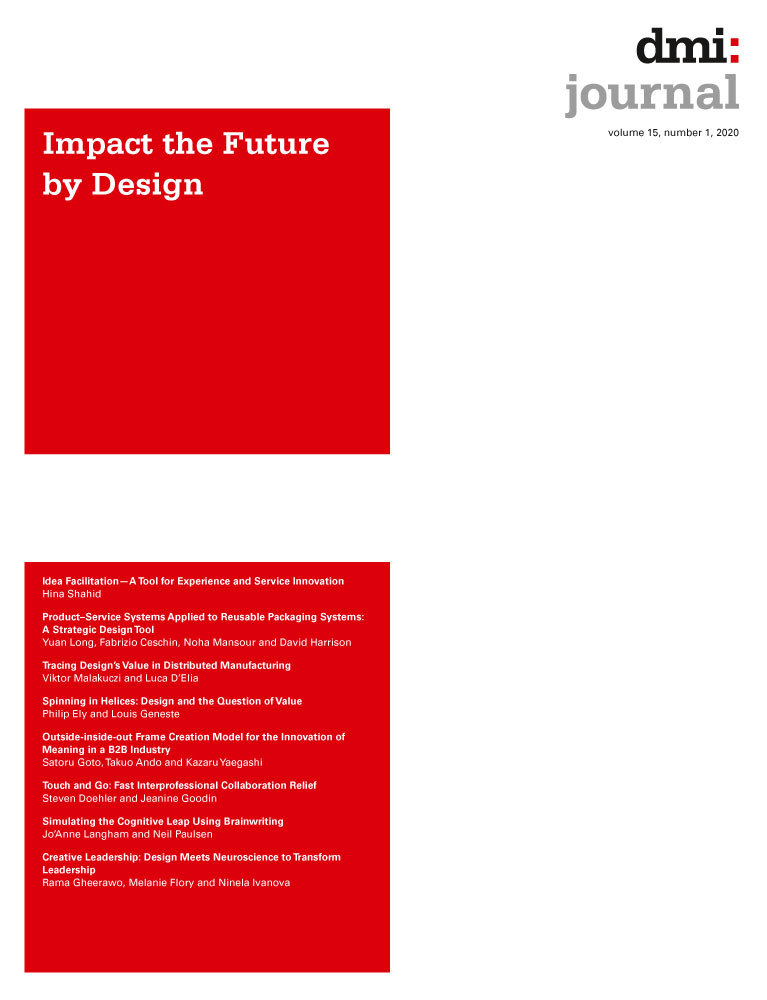Spinning in Helices: Design and the Question of Value
Abstract
Whereas those who practice, research, or teach in design are cognizant of the agency of the discipline and its effectiveness for situational change, potential commissioners or clients of design are still to be persuaded of its worth. A number of recent attempts to measure the effectiveness of design have helpfully reignited an interest in design’s value to commercial and societal interests, yet such models for evaluation are not unified to a point where different types of organizations—ranging from the commercially competitive to the socially motivated—can apply them to understand the value of particular design interventions. This paper develops a framework for analysis of the knowledge value of design to an organization or a society, building on the theoretical model of the quintuple helix and “modalities of knowledge,” respectively, and then applies this analytical frame to 10 design (research and practice) projects conducted over a 24-month period. The paper concludes with recommendations on how such a framework—the Design Value Helix—may be developed for future analysis of design value for research, business, and societal use.
1 Introduction
The motivation for the development of this line of inquiry began at an industry event—Design Thinking & Innovation—hosted by Michael Page (recruitment), with industry panelists from BankWest (finance), BHP (mining), and Skills of the Modern Age (training) in Perth, Western Australia. Attended by approximately 90 industry design professionals from traditional design agencies, in-house service, user experience (UX), customer experience (CX) teams, and design academics, the event explored the saliency of design thinking and other paradigms in the local design industry. The most significant question emergent from the event focused on this area of “measurement”—understanding the impact and value of design, on the back of the (then recently) published The Business Value of Design (McKinsey, 2018a) and the McKinsey Design Value Index. “How,” wondered the audience, “do we measure the impact of our work given that design comes in many forms and is used for multiple purposes?”
The McKinsey Design Value Index, drawn from an analysis of 300 publicly listed companies over a five-year period, measured financial performance and interviewed and surveyed business and design leaders. The index is derived from two million pieces of data and more than 100,000 design “actions” (McKinsey, 2018a, p. 2). This work received an Honorable Mention in the 2019 Design Management Institute’s Design Value Awards, building as it did on the work of the DMI’s own Design Value Index. More recently in 2019, digital product design company InVision published its own report on design’s “astronomical impact” (Gonzalez, Goodman, and Walter, 2019, p. 2) following its interviews of over 2,200 designers. This report identified five levels of design maturity within organizations, ranging from Level 1 (“design is what happens on screens”) to Level 5 (“design is a business strategy”; Gonzalez et al., 2019, p. 15). The InVision report used statistical methods across a wide range of interviews with organizations of differing scales (not-for-profits, startups, large corporates) across 24 industry sectors and 77 countries.
An attempt to reconcile the differing approaches from the DMI, McKinsey, and InVision methods into a unified model for evaluating design’s value and impact may prove to be problematic. McKinsey’s survey instrument, for example, includes questions around the work of design teams (e.g., Q. 19 “How effective is your design team at [f]ostering innovation?”; McKinsey, 2018b)—assuming that the company under analysis does actually have a recognised “design team.” Although those particular questions are preceded by questions on the quantitative measures of design performance or promotion prospects of designers and the degree of support from C-level leadership, this particular survey is clearly focused on larger corporate organizations. Even though the InVision analysis of design maturity is open to a broader cohort, the research team recognized that the survey participants were selected from the InVision contact database of potential or current customers who “may have biased responses or may not have a complete understanding of design practices in their company” (Gonzalez et al., 2019, p.6). Given that InVision is a digital product design tool, the types of design interventions or actions reported are likely to be skewed toward design projects in the digital domain, ignoring the obvious broader application of design in other physical (products, tools, or environments) or nonphysical (strategies, processes, systems, or ecologies) form(s).
2 The crucial link between design and economics
All of the approaches mentioned above focus attention on the value that design brings to business, but this neglects the wider social, technological, cultural, and environmental impact that design has on the human-shaped world. To develop an understanding of the impact and value of design, it is important to extend our thinking beyond the methodological and toward the historical and theoretical, for we find useful ideas there that may help us frame our inquiries into the value of design. In Design and the Creation of Value, John Heskett drew our attention to the “problem of reliance on the quantitative,” recognizing that the tacit knowledge applied in design “can neither be explained in terms of rational decision-making, nor be summarized easily in quantitative terms” (Heskett, 2017, p. 145). The neoclassical economic interest in design purely from a quantitative perspective clearly presents problems for designers who can see their value manifest in many aspects of life, but this does not, as Heskett later states, “absolve designers from extending the boundaries of rational analysis and quantitative explanations that can communicate understanding of their practice” (2017, p. 145).
Heskett’s interest in the value of design shaped national policies and corporate strategies (Dilnot, 2016), and he drew on new growth theory—in particular the work of Schumpeter (1934) and Romer (1986)—to develop his own value creation theory, which placed the knowledge of users (ergo design) as an important “factor of production.” It is worth examining these ideas more closely, for they help us position design in a wider economic context. Schumpeter’s ideas on capitalist markets may be summarized by the sum “Technological Development + Competition = Economic Growth,” but his most popular idea is that new technological revolutions would replace old ones every 50 years or so in a process of what he called “creative destruction” (Schumpeter, 1934). Romer added to Schumpeter’s concept by emphasizing the role of knowledge in the generation of capacity and capability for innovation strategies (Romer, in Heskett, 2017, p. 106). Heskett goes one step further by suggesting that it is the knowledge of users, coupled with technologies (hardware or software) that generates capabilities for innovation strategies and that this knowledge leads not only to product innovations but also process innovations (affecting production quality) and transaction innovations (manifested in transaction efficiencies; Heskett, 2017, p. 151). Importantly, in both new growth theory and Heskett’s value creation theory, imperfect competition leads to the destruction of existing products and the dynamic creation of new demand, new markets, and—of course—new users. Design is to be found both in the context of production (economic value, technological opportunity, and social institutions) and context of use (utility, systems, product, and meaning). For Heskett, designers must function in the conceptual space between designing to improve the capability of users of a product, understanding and shaping end-user beliefs and symbolisms, and understanding the systemic nature of use (e.g., electrical, cultural, broadcasting in the case of media; Heskett, 2017, p. 147).
What is helpful about Heskett’s analyses of new growth theory and design is that design is clearly identified as a form of knowledge that fuels growing economies. Indeed, his subsequent design policy work in the UK, Hong Kong, and China makes this link between design, knowledge, and innovation most explicit as he advised national and regional governments on the economic benefits of design-led innovation. However, the downside of an analysis of the value of design in an economic context is that it suits neoliberal capitalist societies—and specifically the interests of businesses (capitalists)—but is not applicable to instances where the role of design is not purely for economic purposes. For this, we must extend our thinking away from the techno-economic imperative and toward a more ecological point of view of design-led innovation and innovation ecosystems.
3 Innovation ecosystems
Instructions for working with raw materials are inherently different from other economic goods. Once the cost of creating a new set of instructions has been incurred, the instructions can be used over and over again at no additional cost. Developing new and better instructions is equivalent to incurring a fixed cost. This property is taken to be a defining characteristic of technology. (Romer, 1990, p. S72)
The how-to of technological change—Romer’s “instructions”—is precisely what innovation entails: the creation of a distinct framework for action in which systems, processes, and things coalesce around a unity of productive (most often) consumption. It is the knowledge of things, people, processes, materials, and markets that brings about new innovations.
Romer’s ideas have been developed further by Gibbons et al. (1994), who have explored more contemporary changes in knowledge production that fuel this engine of social and technological change. They refer to two forms of knowledge production: Mode 1 and Mode 2. Mode 1 is knowledge production (of ideas, methods, values, and norms) that has “grown up to control the diffusion of the Newtonian model to more and more fields of enquiry and ensure its compliance with what is considered sound scientific practice” (Gibbons et al., 1994, p. 2, emphasis added). Mode 1 knowledge may be seen as identical to our ideas of what we generally perceive to be “science”—a knowledge of cognitive and social norms that determine how science is to be practiced. For Gibbons and colleagues, if Mode 1 knowledge is conducted by an academic community of scientists who “govern” the legitimacy of that knowledge, then Mode 2 forms of knowledge are “more socially accountable and reflexive” (1994, p. 3) and are transdisciplinary in nature. Further, Mode 2 forms of knowledge are produced in the context of application, creating a sense of supply (academia) and demand (industry)—although not exclusively, for Gibbons et al. suggest that Mode 2 forms of knowledge have gone “beyond the market” (1994, p. 3) and can also be seen as “socially distributed knowledge.”
Kari Kuuti is one of the earliest scholars to recognize that design—and design research—exhibits attributes of Mode 2 knowledge insofar as design knowledge has operated in the context of its application, is transdisciplinary in nature, and “is distributed to stakeholders in the process of production itself” (Kuuti, 2007, p. 3). Bærenholdt et al. (2010) have argued that Mode 2 design research “acknowledges that research, design and society are heavily integrated, since research contributes to assembling society and society is a constant field of testing and experimenting in research and design” (2010, p. 4). Design has certainly resisted moves by design science scholars to hold it to account in a Mode 1 state in which legitimate knowledge claims in design can only be made through scientific methods (a similar move was resisted by the social sciences in the so-called science wars, during which time two opposing camps of empiricism and social relativism publicly endangered the science “warriors” and the “science bashers” in a display of intellectual prejudice and self-indulgence; cf. Ross, 1996).
As design researchers have come to understand Mode 1 and Mode 2 forms of knowledge, Elias Carayannis and David Campbell have built on these concepts still further through their studies of knowledge, innovation, and the environment. They have developed an expansion of Mode 1 and Mode 2, considering the more complex ways that knowledge is created through multilayered, multimodal, multinodal, and multilateral system(s) in which diverse worldviews shape what we consider to be specialized knowledge. Calling this form of knowledge creation Mode 3, Carayannis and Campbell argue that a Mode 3 system of knowledge creation is “the nexus or hub of the emerging 21st century Innovation Ecosystem” (2009, p. 202), in which new knowledge and innovations are borne out of coevolution, cospecialization, cooperation, and—occasionally—“co-opetition” (Carayannis and Campbell, 2019, p. 221), an awkward compound version of cooperative competition.
Over the last 10 years, Carayannis and Campbell have developed their thinking around Mode 3 forms of knowledge in two important ways. First, recognizing the changing landscape of innovation, sustainable development, and economic growth in a complex, interconnected world, they argue that it is “crucial to accept and to foster a pluralism of different knowledge and innovation modes (paradigms) … enabling a mutual cross-learning of different knowledges”(Carayannis and Campbell, 2019, p. 20). The competitiveness and superiority of a knowledge system is “highly determined by its adaptive capacity to combine and integrate different knowledge and innovation modes” (2019, p. 21), applying these principles of coevolution, cospecialization, cooperation, and competition. In other words, the innovative capabilities of nations, societies, and knowledge systems (disciplines), and perhaps organisations, rely on the capacity to think and act plurally—to consider that one’s own knowledge system may not be the only one capable of confronting complex innovation problems. One only has to look at the different ways people are looking to solve the COVID-19 pandemic to see this in action. This is a viewpoint that may well be shared with that of Arturo Escobar, whose recent Designs for the Pluriverse argues for a pluriversal design practice that brings perspectives from both the Global North and the (often overlooked) Global South to confront the world of transition that we face (Escobar, 2018, pp. 2–4). Although seen largely as an anthropologist, Escobar has an intellectual interest in urban planning, design, self-organization, and—like Carayannis and Campbell—systems thinking and knowledge systems. All three authors recognize the emerging importance of pluralist perspectives in contemporary knowledge systems (cf. Ely, 2020).
The second significant conceptualization of Mode 3 knowledge is in relation to what is described as the Quintuple Helix (Carayannis and Campbell, 2019). The origins of this conceptual layer to forms of knowledge (or knowledge creation practice) lie in the Triple Helix model of university-industry-government relations (Etzkowitz and Leydesdorff, 2000). In their original article, Etzkowitz and Leydesdorff presented a simplified model (Figure 1).
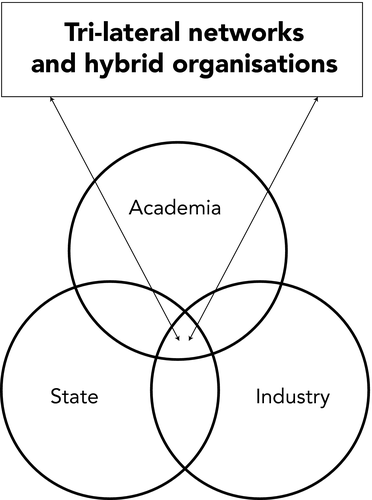
Recognizing the different states of flux and reorganization, the authors revise this static model for relationships between the three by showing an unstable Triple Helix (Figure 2).

Carayannis and Campbell have subsequently revised this model, initially proposing the Quadruple Helix, which added a fourth helix, the public, or more fully described as the “media-based, culture-based and values-based public” (2010, p. 51). This fourth helix extends the Triple Helix by considering how (public) culture and values shape innovation, and it uses the example of how “visions in the arts perhaps trigger, in the long run, the development of a new technology or the launch of a next technology cycle” (Carayannis and Campbell, 2010, p. 51). Widespread use of, for example, digital media technologies, which have now become ubiquitous to everyday life, leads to the public shaping (and to the acceptance or rejection of) new digital practices and digital technologies. The social production of knowledge reveals the “accountability and reflexivity” (Carayannis and Campbell, 2010, p. 51) of Mode 2 forms of knowledge; here, we see the interplay between the concept of Mode 2 and the Quadruple Helix.
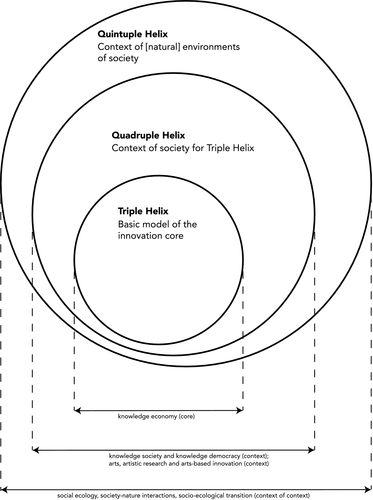
The more recent Quintuple Helix model (shown above in Figure 3) acknowledges the pluralism of transdisciplinary and polyvocal knowledge creation while also adding the fifth helix of both our natural environment and our social environments (our social ecologies). Here, knowledge is sensitive to the forces of society, democracy, the economy, and the natural environment (Carayannis and Campbell, 2019, p. 46). This model is best explained by the authors’ conceptualization: If we are to reconcile the “types” of knowledge (Mode 1 to Mode 3) and the helices that describe the innovation ecosystem in which they appear into a single model, we might present the following diagram (Figure 4):
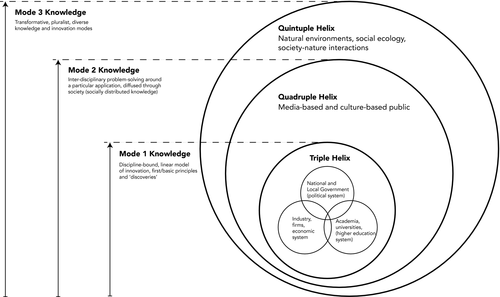
Carayannis and Campbell suggest that arts, artistic research, and arts-based innovation provide an essential source of creativity to advance innovation and that “different disciplines of the arts” (2019, p. 44) extend sciences, social sciences, and humanities through their transdisciplinarity in the process of Mode 2 knowledge creation. Design is perhaps one of those disciplines that is able to extend the co-creation capabilities of all of the sciences; it certainly appears to exhibit the attributes of Mode 2 knowledge capability (Bærenholdt, 2010; Gregory, 2009, p. 251; Kuuti, 2007).
4 Design in the innovation ecosystem
One of the limitations of Carayannis and Campbell’s thinking is perhaps the view that arts and arts-based innovation operate as a Mode 2 form of knowledge. Given that recent postcolonial and transition design movements in particular (Akama and Yee, 2019; Irwin et al., 2015; Tlostanova, 2017; Van Selm and Mulder, 2019) have now widened designers’ theoretical concerns and practical engagements with communities and societies beyond the hegemonic, technocentric ones of the Global North (cf. Fry, 2017), the transformational and culturally open-minded design discipline is opening itself to other worldviews: epistemologies, ontologies, and practices from domains beyond those of the Western world. This embrace of plurality and attention to transformations would appear to locate some—though obviously not all—forms of design or design actions in the domain of Mode 3 knowledge. Design’s collective work with indigenous communities demonstrates the way that design knowledge works in tandem with First Nation peoples’ knowledge to co-design more sustainable, human, and fauna- and flora-centered worlds (Akama 2017; Akama, Hagen, and Whaanga-Schollum, 2019; Akama, Keen, and West, 2016). Not everything that designers do is at the behest of the business imperative—a mere Mode 1 form of knowledge production.
Design, then, appears to find its place in knowledge production throughout the triple, quadruple, and quintuple helices and in many modes: 1, 2, or 3. The questions are where, when, and how? What does Mode 1 design knowledge compared to Mode 2 or Mode 3 look like? Can we recognize design in the innovation system, and where should we locate our design “actions”? Perhaps, how might we “measure” or see it in each helix and in various modes? In the following section, we explore how Carayannis and Campbell’s model may be adapted to explain what we describe as the Design Value Helix.
5 Locating design in the Design Value Helix
The synoptic view shown above of knowledge and the helices in which it operates has emerged from a literature playing close attention to innovation and entrepreneurship ecosystems and the actors (i.e., firms, research institutions, policy makers, publics, communities, and societies) who fuel these ecosystems. As individual designers, design researchers, or design firms, we can comfortably locate our work somewhere in these spinning helices of innovation, applying one type of knowledge or another. As professional designers, we would probably find ourselves located mainly in the Triple Helix, fuelling firm-to-firm, academia-to-firm, firm-to-government, or firm-to-academia interaction. Such firms, of course, take many forms (including not-for-profits and charitable sectors), but work here tends to be contractual and transactional, with business imperatives at the forefront. Even work in the public (government) sector fuels business innovation (e.g., the design of a regional business development service), although much of it is centered on the provision of public services (e.g., health, education, leisure services), which, again, require the raising of contracts, the setting of specific business goals, and the design of products, services, and human–computer processes. Whereas knowledge of users (Kuutti, 2009) may provide organizations with much-needed insights for the effective development of new innovations, in the Triple Helix—and at Mode 1—business and technical priorities are privileged over customers or publics. In Mode 1, a business or process leader (usually a client) will prioritize financial viability and technical feasibility over end user desirability. That is not to say that such concerns are rejected altogether, but simply that commercial or organizational realities limit the degree to which an organization can truly engage in a program of human-centered design that will satisfy the demands of its customers, end users, or stakeholders. Designers working in large organizations with marketing, operations, and tech functions will have experienced the tensions inherent in these priorities. Measures of performance in this area will align with those we might expect to see in econometric evaluations: increases in sales, reductions in production cost, return on investment, or similar.
In Mode 2, design begins to operate in a meaningful space where wider publics (i.e., media and culture) are actively engaged in the development of new products, services, and processes. Whether funded by philanthropists, charities, local or national governments, or socially responsible commercial entities, these are projects located in the Quadruple Helix and grapple with the interagency and intracommunity complexities of designing for the public good. Commonly cited examples include rural development projects in remote communities or more radical, political forms of design activism, such as Van Lier’s showcase of 31 designers “fighting for a better world” as part of the What Design Can Do annual conference (Van Lier, 2018). Measures of performance here may still be quantitative in nature (e.g., in the number of individuals engaged in a public project), but they may be complemented by qualitative measures such as well-being or happiness captured through human narratives.
In the Quintuple Helix, the design stakes are much higher. Here, design projects (and designers) engage in projects that consider the wider ecology and society in which they live, draw upon different types of knowledge (practical, ethical, technical) from a diverse community of many worldviews, and synthesize and develop designs that manage to reconcile the needs of business, government, many publics, and the environment—transforming them in the process. Such design actions and projects may be rare, but their rarity sets a gold standard in design effectiveness. Although there may be an increasing number of projects that set out to design the transformational change that the transition design movement calls for, the number that actually deliver on their promise may be tantalizingly elusive—but that should not be through want of trying! In the Quintuple Helix, measurement of performance may take a largely qualitative, narrative form, supplemented by a full gamut of quantitative measures that may still include end user numbers, financial benefits, and public media audience figures. Projects are likely to demonstrate widespread behavior change, the harnessing of complex systems toward common Earth goals, and, most importantly, sustainable designs likely to satisfy spiritualist, ecologist, and materialist values and outcomes.
In the revised diagram below, we show the Design Value Helix (Figure 5):
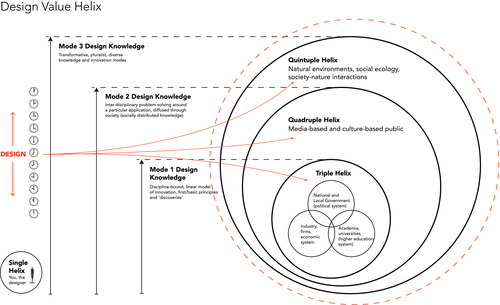
In the Design Value Helix, design actions can be found in one of the three helices. The precursor to any action appearing in one of the helices is the single helix—a world in which the designer operates singularly and initially disconnected from the outside world. The single helix marks the early stage of projects where the designer is still formulating design approaches, still developing designs, and working on design “intent.” Whether projects are self-initiated or commissioned by clients, the single helix represents the period of early design development.
On the left-hand side of the diagram, a design action (DESIGN) is seen to move temporally through modes or helices, acknowledging that design actions or initiatives that start in one effective mode can end up in another. For example, a project to design a sustainable form of transport may begin as a funded commission by an industry partner or client, become popular in public consciousness, and eventually change patterns of behavior around urban travel. In this case, a project that engages the public and a community in its development and eventually influences (positively) a society would have applied Mode 1, 2, and 3 knowledge and shifted its influence from the Triple Helix toward the Quintuple Helix. Such an outcome can only be observed through time, so the effect of design actions can permeate across all three modes.
6 The Design Value Helix in action
For the designer, design manager, or design commissioner, questions arise about how our proposed theoretical model might be applied to the practical measurement of the impact or value of design. Here, we apply this model to an evaluation of a number of projects emergent from design research in one university and show how the Design Value Helix can be used as an evaluative framework of design value. We evaluated 10 projects (Table 1) in their current state (at time of writing), with each project having a slightly different disciplinary emphasis ranging from social design (working for the social good) to design thinking (applying an IDEO or Design Council model) to communication design (graphic design) to broader design-led innovation (confronting design challenges through a variety of methods/frameworks).
| No. | Project Name | Project Type | Description | Status |
|---|---|---|---|---|
| 1 | ResourcesX | Social Design/Design Thinking | Two-day executive education training using design thinking methods applied to three real-life not-for-profit design challenges | Completed |
| 2 | Social Design in Action | Social Design | The co-design of integrated health, education, and community services | Terminated |
| 3 | GNSS Infographic | Communication Design | Design of an information visualization for geospatial science research for public and government audience | Completed |
| 4 | Officer Preparedness | Design Thinking/Design-Led Innovation | Initial half-day co-creation workshop for officer preparedness for domestic violence incidents | Ongoing |
| 5 | Future of Energy | Design-Led Innovation | Large energy provider initiative for multi-agency collaboration | Ongoing |
| 6 | The State of Design | Communication Design/Design Leadership | Design advocacy project | Ongoing |
| 7 | Research Branding | Communication Design | Two brand identities: research group and research program | Completed |
| 8 | Humanities | Design Thinking/Communication Design | Collaborative workshop and publication | Near Completion |
| 9 | Mental Health Design | Social Design/Design Thinking | Student-led co-design of mental health services | Completed |
| 10 | Energy Innovation | Design-Led Innovation/Design Thinking | Student-led co-design of improved innovation ecosystem between energy provider and startups | Completed |
The first stage of evaluation was to locate each project within the helix/mode that best described the nature of the project and the mode of knowledge (Figure 6), but given that project status and project intent vary, a further analysis is required (Table 2).
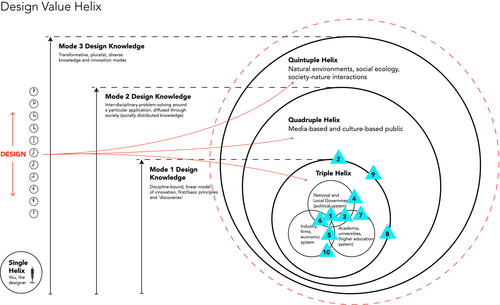
| No. | Project Name | Status | Mode | Helix | Success Metrics (Initial) |
|---|---|---|---|---|---|
| 1 | ResourcesX | Completed | 1 | Triple | Increase in innovative approaches, improved staff empathy |
| 2 | Social Design in Action | Terminated | 2 | Quadruple | Improved life outcomes for children, in-work parents, improved health, and more |
| 3 | GNSS Infographic | Completed | 1 | Triple | Peer and government understanding of fundamental science |
| 4 | Officer Preparedness | Ongoing | 1→2 | Triple, likely to extend to Quadruple | Decrease in officer harm, improved victim support, decreased perpetrator injury or death |
| 5 | Future of Energy | Ongoing | 1 | Triple | Streamlined innovation process, increase in interagency collaboration |
| 6 | The State of Design | Ongoing | 1 | Triple | Increased government and business awareness of design capabilities within state |
| 7 | Research Branding | Completed | 1 | Triple | Broader awareness in academy of design research |
| 8 | Humanities | Near Completion | 1→2 | Triple→Quadruple | Broader awareness in academy of humanities research, increased engagement with humanities researchers, wider public awareness |
| 9 | Mental Health Design | Completed | 1→2 | Triple->Quadruple | Key service stakeholders collaborating to support young adults (achieved); decrease in self-harm, suicides, and other indicators (currently unmeasured) |
| 10 | Energy Innovation | Completed | 1 | Triple | Industry partner provided with tools to increase startup/corporate interaction |
This second level of analysis reveals the diagnostic strength of the Design Value Helix model, for it requires the design team to return to the original project intent, evaluate performance based on this intent, and understand what the ultimate project outcome is likely to be. The success metrics here are defined by the initial brief, but projects may go beyond (or fail to deliver) these quantitative or qualitative goals and success metrics may change. For example, Project 4 is still ongoing, and an initial collaborative design sprint with law enforcement officers, lawyers, and emergency services personnel is likely to continue to engage key stakeholders from multiple agencies. What began as a possible digital technology challenge that might have been “solved” by the development of a mobile app has now become a design project looking at service interoperability, interagency working, and—most importantly—has become more human-centered from the perspective not only of officers, but also victims and perpetrators of crime. For this reason, an initiative we first identified as fitting a Mode 1 knowledge project falling under the Triple Helix innovation process is now classified as a Mode 2 project following the Quadruple Helix process. In this example, the Design Value Helix model shows its potential as a tracking tool that follows the evolution of a project and its likelihood of achieving broader and more aspirational community goals.
Furthermore, an analysis of how projects have come to their current position in our helices (i.e., the mode of knowledge required to develop them) reveals that although some projects may be completed, their legacy continues. In Project 9, for example, a group of postgraduate students worked with a regional health funding body to identify possible service offerings or process improvements that would improve young adults’ mental health. The students engaged not only with discreet stakeholders identified by the client funder but consulted with a wider public (albeit in one-to-one interviews) to understand multiple perspectives. Here, they drew on knowledge beyond the expert group and in the wider community (Mode 2). Although their insights and design ideas were presented to the client (and a service provider) in a typical Triple Helix environment (university-government-industry), the ideas presented are likely to be socialized into broader public consultation and future service development (Quadruple Helix). The project may have “finished,” but their design legacy lives on. The question is this: will this legacy ultimately demonstrate and achieve quintuple helix outcomes? Only time will tell, and therein lies the need to review projects even after their completion; the Design Value Helix model provides a means of achieving this.
7 Conclusion and further research
In this brief demonstration of how the Design Value Helix model can be applied to the evaluation of design projects, actions, or initiatives, it is clear that there is still further data collection required to provide a granular view of the performance of a project. Metrics such as audience reach (e.g., Project 8), reduction in off-duty staff (Project 4), or project flow (Project 5) would be quantitative measures that would provide detail to the analyses above. However, it is clear that in design actions, such as advocacy projects (Project 6), performance might be better explained in terms of improved government or public understanding, which may only be understood qualitatively. The Design Value Helix enables designers and their clients, managers, or stakeholders to ask two important questions in relation to impact and value: First, how was the project developed (i.e., what knowledge was brought to bear on a given problem area and what knowledge was created)? And, second, how far did the impact of the project extend (i.e., what helix has the design outcome landed in)? The second of the two questions highlights the temporal challenge associated with all design-related projects. As we pointed out earlier, even after projects have been completed, their legacy continues, and the Design Value Helix model provides a mechanism with the potential to measure, retrospectively, the far-reaching effects and outcomes of design-led initiatives. Only time will tell whether this potential will be realized.
Biographies

Philip Ely PhD MISTD FRSA FHEA is a Senior Lecturer in design at Curtin University, leading design-led innovation research and practice and is the founder of The State of Design research network across all five universities in Western Australia (https://thestateofdesign.org/). He served his formative years at Total Design and IBM before serving in senior design roles at The Brilliant Agency, Telstar Records plc, Granada Media and Design Bridge before joining academia in 2002. He earned his PhD at the University of Surrey's Digital World Research Centre in 2012 and has since published work on new interactive technologies, entrepreneurship and design.

Louis Geneste PhD lectures and researches in entrepreneurship, innovation and small business in the Faculty of Business & Law at Curtin University. Louis completed his PhD in 2010 with the Graduate School of Business at Curtin University. Louis’ research interests include small business growth and success, knowledge acquisition and innovation and small business scams and is a memebr of The State of Design research network. Louis has been involved in small business for over twenty years having owned and managed a number of small and medium enterprises.



